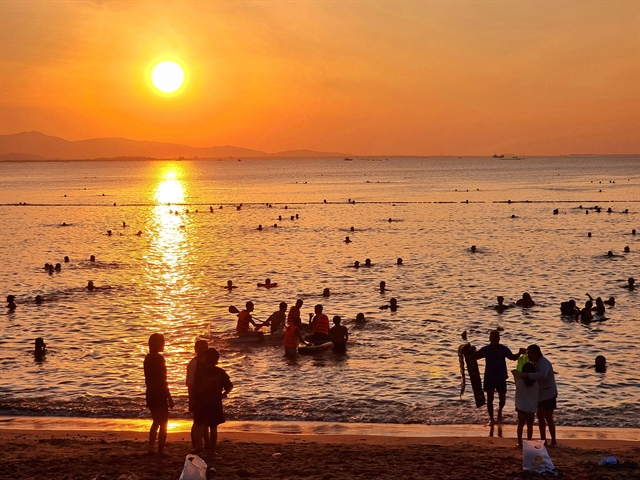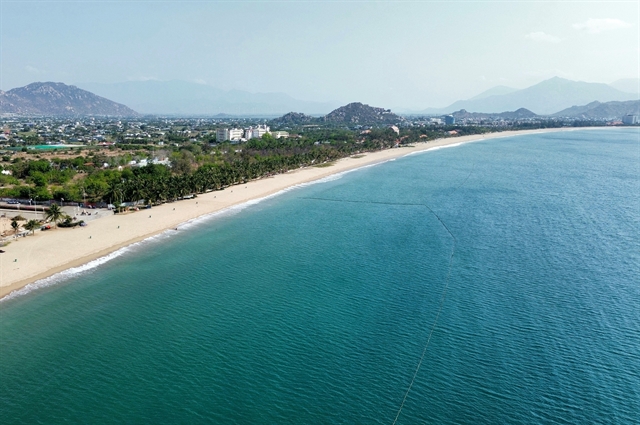 Life & Style
Life & Style

 |
| Tourists at Bình Sơn Beach in the coastal province of Ninh Thuận. — VNA/VNS Photo Nguyễn Thành |
HÀ NỘI — Việt Nam aims to turn tourism into a major economic sector with green growth and world-class development potential by 2030.
This is part of a master plan on tourism for the 2021-2030 period recently approved by Deputy Prime Minister Trần Hồng Hà.
The plan's goals for 2025 are for Việt Nam to welcome between 25 million and 28 million international arrivals, with 130 million domestic travellers and an annual growth rate of 8-9 per cent in the number of domestic tourists.
By 2030, the number of international tourists will reach 35 million, increasing 13-15 per cent each year, while domestic travellers will reach 160 million and grow 4-5 per cent annually, according to the plan.
Tourism is expected to directly contribute 8-9 per cent and 13-14 per cent of gross domestic product (GDP) by 2025 and 2030, respectively.
Under the master plan, this sector will create about 6.3 million jobs (including 2.1 million direct jobs) by 2025, and 10.5 million jobs (including 3.5 million direct ones) by 2030.
Việt Nam is working to recover and grow domestic tourism over the next few years.
Meanwhile, it is set to tap into the markets of high-spending tourists and tourists that stay for long periods of time, along with new markets like golf, sports and adventure tourism.
Efforts are being made to revive traditional markets and attract visitors from emerging ones, like India and Middle Eastern countries.
Over the next several years, Việt Nam is planning to maintain and expand traditional markets in Northeast Asia, Southeast Asia, Europe, North America, Russia, Eastern Europe and Oceania, while diversifying markets to increase the proportion of wealthy travellers.
By 2045, tourism is expected to establish itself as a main economic driver, and Việt Nam will become a globally desirable destination and one of the countries with the strongest tourism development in the Asia-Pacific region, according to the master plan.
The plan also hopes to achieve 70 million international arrivals and about VNĐ7.3 quadrillion (US$287 billion) in tourism revenue, increasing the tourism sector to contribute 17-18 per cent of GDP by 2045.
Tourism development is expected to play a role in preserving and promoting cultural values, creating livelihoods for the local communities and improving their quality of life.
Environmental protection and climate change response is also a focus, with a goal that no tourist destinations, accommodations or service establishments use single-use plastic products and non-biodegradable bags by 2030.
The sector is also expected to contribute to the country’s social order and safety and overall security, as well as territorial integrity.
 |
| Ninh Chữ Beach in Ninh Thuận Province. — VNA/VNS Photo |
Product development will prioritise sea and island tourism potential, particularly ecotourism products based on Việt Nam’s strength in natural resources with world biosphere reserves and national parks as well as nature and marine reserves.
Meanwhile, urban tourism will expand cultural industries and the nightlife economy.
New tourism models will be developed in alignment with new market trends such as health and wellness tourism, agricultural and rural tourism, sport and adventure tourism or MICE (Meetings, Incentives, Conferences and Exhibitions) tourism among others.
Each region also plans to customise their tourism products based on their unique features, while also building regional tourism brands by strengthening regional connections.
The plan also outlines the country’s spatial development for tourism, which includes various tourism zones, growth drivers, main tourism routes and tourism centres, as well as national tourism destinations. — VNS




